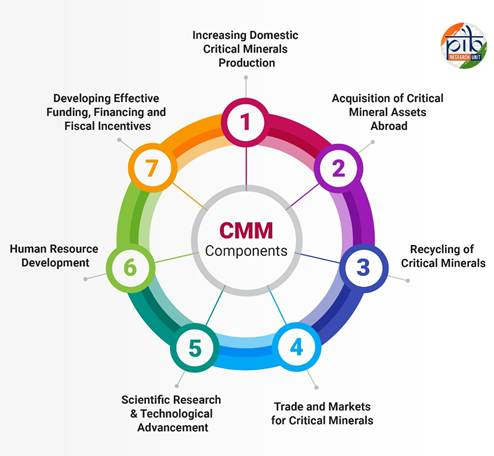Indian Economy
National Critical Mineral Mission (NCCM)
- 11 Apr 2025
- 6 min read
Key Facts
|
About the National Critical Mineral Mission
- About: The Union Cabinet approved the launch of the National Critical Mineral Mission (NCMM) with an expenditure of Rs 16,300 crore in January 2025.
- The Finance Minister announced the launch of the Critical Mineral Mission in the Union Budget 2024–25.
- The NCMM will adopt a "whole-of-government" approach, working closely with various ministries, Public Sector Undertakings (PSUs), private companies, and research institutions.
- Empowered Committee on Critical Minerals: The Ministry of Mines is the administrative Ministry of the mission.
- The mission’s activities are coordinated by an Empowered Committee, chaired by the Cabinet Secretary and including members from relevant stakeholder ministries.
- Objectives:
- To secure India’s critical mineral supply chain by ensuring mineral availability from domestic and foreign sources.
- Strengthening the value chains by enhancing technological, regulatory, and financial ecosystems to foster innovation, skill development, and global competitiveness in mineral exploration, mining, beneficiation, processing, and recycling.
- Exploration Projects: Under this mission, the Geological Survey of India (GSI) has been tasked with conducting 1,200 exploration projects from 2024-25 to 2030-31.
Critical Minerals
- Critical minerals are those minerals that are essential for economic development and national security. The lack of availability of these minerals or concentration of extraction or processing in a few geographical locations may lead to supply chain vulnerabilities and even disruption of supplies.
- A committee formed by the Ministry of Mines in November 2022 identified 30 critical minerals, with 24 included in Part D of Schedule I of the Mines and Minerals Development and Regulation Act, 1957 (MMDR Act, 1957).
- Inclusion in Part D grants the Central Government exclusive authority to auction mining leases and composite licenses for these minerals.
- The list of 30 critical minerals released by India includes the following:
- Antimony, Beryllium, Bismuth, Cobalt, Copper, Gallium, Germanium, Graphite, Hafnium, Indium, Lithium, Molybdenum, Niobium, Nickel, PGE, Phosphorous, Potash, REE, Rhenium, Silicon, Strontium, Tantalum, Tellurium, Tin, Titanium, Tungsten, Vanadium, Zirconium, Selenium and Cadmium.
Components of the Critical Mineral Mission
- Increasing Domestic Critical Minerals Production:
- Mining in Offshore Areas: Polymetallic nodules, rich in cobalt, Rare Earth Elements (REEs), nickel, and manganese, are being targeted through intensified offshore exploration and planned mineral production.
- Critical Minerals Regulatory Support Programme: A fast-track regulatory approval process for domestic critical minerals exploration and mining projects is being created.
- Acquisition of Critical Mineral Assets Abroad:
- Mapping and Acquisition of Significant Critical Mineral Assets: The Mission will fund and support mapping and detailed exploration of critical mineral assets in resource-rich countries outside India.
- Encouraging Private Sector Companies: To encourage the participation of Indian public and private sector companies in the acquisition of assets abroad, the Government will provide targeted subsidies for mining, and for setting up evacuation infrastructure with appropriate finances.
- Trade and Markets:
- Enhance Trade with Resource-Endowed Countries: India will pursue Critical Minerals Partnership Agreements and integrate critical minerals chapters into FTAs.
Develop National Critical Mineral Stockpile/Reserves: A joint initiative between central PSUs shall be institutionalised to develop a National Critical Mineral Stockpile/ Reserves Programme, to guard against supply disruptions and aid mineral supply for domestic utilization.
- Developing Effective Funding, Financing, and Fiscal Incentives:
- Leveraging Funding from National/International Institutions: The government will facilitate participation from institutions like the World Bank, ADB, and IMF.
- Integrating with Existing Schemes: While making new schemes and guidelines to fund government activities, care will be taken to link or combine them with any similar existing schemes under the Mission.
Related Key Initiatives
- Khanij Bidesh India Ltd (KABIL): A joint venture of the Ministry of Mines, acquired a vast area in Catamarca, Argentina, for lithium exploration and mining.
- Mineral Security Partnership (MSP): Collaboration of 14 countries and the EU, evaluating 32 Critical Minerals projects across various countries.
- Initiative on Critical & Emerging Technologies (iCET): Announced in 2022, 12 projects have been prepared for taking up under iCET.
- Quad Investors Network (QIN): Quadrilateral Security Dialogue (Quad) partners have set up the Quad Investors Network (QIN), with a working group focusing on clean energy and critical minerals.Initiative on Critical & Emerging Technologies (iCET): Announced in 2022, 12 projects have been prepared for taking up under iCET.





